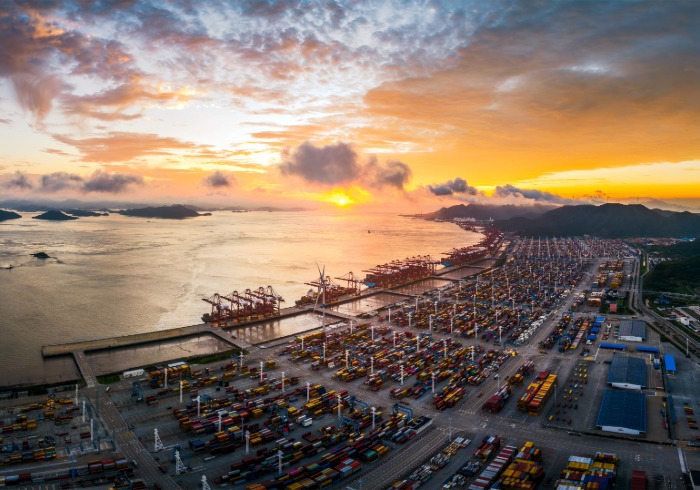Bewitched by the promise of a wholesale transformation of trade, financial institutions and investors have poured vast sums into distributed ledger technology (DLT). But following the failure of one large bank-backed initiative and the decision by a high-profile startup to replace blockchain with a more scalable alternative, has the technology had its day? Eleanor Wragg reports.
When the World Trade Organization (WTO) published a report in 2018 declaring that blockchain would add US$3tn to international trade by 2030, it came as little surprise. At the time, the technology was in what the global body called a phase of “irrational exuberance”, and its transparent, decentralised and immutable nature was seemingly the panacea to all of trade’s woes.
In recent years, multiple use cases for DLT in trade have sprung up, from fraud detection to asset distribution, ESG tracking, and the digitalisation of documentary and open account trade finance.
Banks joined together in consortia, often spreading their money across multiple competing platforms, while fintech entrepreneurs raced to bring new concepts to market.
The assertion by Emmanuelle Ganne, WTO senior analyst and the report’s author, that blockchain could be the biggest disruptor to international trade since the invention of the shipping container, was widely accepted as gospel, and for good reason: the technology’s characteristics neatly address the pain points that have plagued global trade for so long.
Distributed ledger technology: the panacea for trade?
Blockchain technology involves a distributed database – or ledger – maintained over a network of computers connected on a peer-to-peer basis. It allows network participants to share and retain records in a secure, verifiable and permanent way, which means products, transactions and documents can be traced easily. It is also nearly impossible for any user to tamper with previously recorded transaction data, which means participants who don’t necessarily trust each other – for example, counterparties to a trade finance transaction – can collaborate without having to rely on a third party. Blockchains can be public, private or managed by a consortium of companies, and they can be accessible by everyone or restricted.
For the US$5.2tn global trade finance ecosystem, which still relies upon paper to facilitate the movement of goods and services around the world, the potential of blockchain is enormous. The transformation of the letter of credit (LC), a trade finance instrument that has been in use since the Sumerians inhabited southern Mesopotamia, is one good example of blockchain’s utility. According to research carried out by the Boston Consulting Group (BCG) and Swift, the process commonly involves more than 20 separate entities for a single trade finance deal, with the necessary data typically contained in 10 to 20 different documents, creating approximately 5,000 data field interactions. The efficiency gains from putting this instrument in digital format onto a blockchain are huge. Indeed, Contour, a multi-bank consortium that has dedicated itself to doing precisely this, has managed to slash LC processing times by over 90%, from between five and 10 days to under 24 hours. Cutting processing times means saving costs, which means – in theory at least – that banks can do more with less, enabling them to offer more trade finance to more exporters.
Another consortium, we.trade, which counts among its backers some of the same banks that invested in Contour, set its sights on open account trade. Using blockchain and smart contracts, it linked the parties involved in trade and registered the entire trade process, guaranteeing automatic payment when all contractual agreements have been met. Among the products available were the bank payment undertaking (BPU), where the buyer’s bank provides the seller with an irrevocable undertaking to pay the invoice at maturity date, and BPU financing, where the seller’s bank provides financing by discounting the BPU.
It wasn’t just banks who came together to drive the use of DLT. The Komgo platform, set up to digitise and streamline commodity finance, brought together a mix of corporate and financial players, with ABN Amro, BNP Paribas, Citi, Crédit Agricole, Gunvor, ING, Koch Supply & Trading, Macquarie, Mercuria, MUFG Bank, Natixis, Rabobank, Shell, SGS and Société Générale as its initial shareholders.
Meanwhile, beyond the nuts-and-bolts financing of trade, numerous startups also came to market with blockchain-based solutions to peripheral problems. Financial technology solutions provider MonetaGo, for example, took aim at duplicate financing fraud. Its network enables financiers to create a unique digital fingerprint for documents such as invoices and then publish them to a blockchain-based decentralised registry, enabling them to check no-one else had financed it without revealing client information. It achieved rapid success, linking up with the GUUD ecosystem to implement its fraud prevention solution across Asia, and connecting its Secure Financing system to the global Swift network of banks via API-enabled infrastructure.
For a time, it seemed as if blockchain would be the key to attaining the holy grail of trade digitisation, making trade faster, better and safer for all. But, as the industry started to move from small-scale initiatives and proofs of concept towards live global activity, problems began to emerge.
The fight for financial viability
In May this year, we.trade closed its doors after being unable to secure further investment to continue as a going concern – despite having some of the world’s biggest banks and tech behemoth IBM as backers.
Established as an independent company in 2017, the company’s shareholders included institutions such as CaixaBank, Deutsche Bank, Erste Group, HSBC, KBC, Nordea, Rabobank, Santander, Société Générale, UBS and UniCredit. In 2019, we.trade brought its Hyperledger Fabric-based technology to market under a software-as-a-service model and onboarded 16 banks across 15 countries onto its platform. “we.trade found a way to turn competitors into collaborators,” said Mark Cudden, its then-chief technology officer. “Strong governance helped with convincing others to join. Most importantly, the benefits of working together to realise a shared vision to solve a shared problem were much greater than the fear of technology.”
However, transforming trade takes time, and banks tend to want to see a return on their digitisation investment dollars sooner rather than later. It didn’t take long for the platform to run into financial difficulties. In 2020, it was forced to slash its workforce by around half, after funding raised from some shareholder banks proved lower than expected, with many opting not to reinvest. An eleventh-hour cash injection from IBM enabled it to keep going, and a new capital round, in which we.trade managed to raise €5.5mn, took place in 2021. Unfortunately, that was only enough to keep it afloat for another 18 months, and, unable to convince its investors to continue to stump up cash, the company was forced into closure.
Having seen we.trade fail, one industry source told GTR at the sidelines of the recent GTR UK conference, banks are now more reticent about investing into blockchain technology. “Banks now need to know that you will still be around in three years’ time,” the source said.
we.trade did not respond to repeated requests for comment by GTR, but representatives of other bank-backed consortia are also familiar with the race to achieve success before the funding dries up.
“A blockchain ecosystem’s value is greatest at scale. The problem is, it is very difficult and expensive to build a network like that, and people underestimate the time and money required to reach critical mass,” says David Sutter, chief product officer at Marco Polo Network, which was launched in September 2017 to digitise open account trade, signing up multiple large trade finance banks. “The reason bank-owned consortiums fail is not a technology problem. It’s a business model problem more than anything: it’s very difficult to build a global profit-making enterprise at that scale. We have great shareholders who continue to invest and remain patient, whereas bank-owned consortiums are pure cost centres and that makes them impatient. Sometimes they are only able to look one budgeting cycle ahead. They need to show a return on investment quite quickly, whereas this type of wholesale, market-wide transformation can be a five, 10 or 15-year journey.”
“Scaling is hard,” adds Josh Kroeker, chief product officer at Contour. “But it is possible. It’s almost by design that there is going to be some consolidation, because while you want to have lots of different service providers, you don’t want that many networks. The biggest misunderstanding is around blockchain interoperability, where everybody builds their own network, and over time, they’ll be interoperable. That is not how it works. There are many technological challenges to interoperability, but beyond that, what’s the commercial model? Who gets paid for what side of the transaction? What’s the legal model? Why it’s still working for Contour and why we’ll continue with blockchain is because our vision is still to connect the world’s banks and corporates on a common network. And if you want to connect the world’s banks and corporates on a common network, it has to be decentralised.”
Achieving global scale
Not everyone is convinced that blockchain is in fact able to scale, however. In June, after four years of live production using the technology, MonetaGo announced it was moving its Secure Financing system to cloud computing instead, saying DLT no longer worked for its global use case.
“Once you get to global volumes in trade finance, blockchain ceases to be a competitive technology with respect to performance and cost,’’ Neil Shonhard, president of MonetaGo, told GTR at the time. “The infrastructure required is just excessive.”
“Blockchain works for low-volume, untrusted environments where participants actually want to and are able to host the nodes. But as we’ve reached scale, it no longer meets our needs. Using secure cloud technology, we can preserve data privacy and provide all the same assurances to financial institutions, but we can do it in a way that is much more efficient and scalable for a larger solution,” says Jesse Chenard, MonetaGo’s CEO and co-founder, who adds that the cost component in terms of licensing across multiple different customers had also become a barrier.
MonetaGo is not the only solution provider to scrap the tech. Commodity trade finance network Komgo has also switched out its underlying technology. “You can achieve distribution, immutability and security of data through other highly reliable but less complicated architectures,” Doug Court, head of communications at Komgo, tells GTR. “The main problem blockchain solves for is trust in an anonymous setting, but on a private chain the trust mechanism is established by the terms and conditions that members sign when they join. If there’s any dispute, they’re going to fall back on the contractual documentation, not the technical architecture. At Komgo, our objective is to provide solutions that solve real business problems as efficiently as possible. It’s not to provide a technology. We have more experience working on blockchain-based digital trade finance applications than perhaps any one else. There are challenges when it comes to scaling such complex and expensive technical solutions, so they need to add value, otherwise it’s just not sustainable.”
From crypto to tokens
Arguably, the only truly successful, profitable and scalable application case for blockchain globally has been as an architecture to move money around, be that in the shape of cryptocurrencies such as bitcoin, or in the tokenisation of assets for investors.
Here, says André Casterman, chair of the International Trade & Forfaiting Association’s fintech committee and CEO of the Trade Finance Distribution Initiative (TFDI), is where the real value might lie for trade.
“One use case where DLT adds value is to act as a tracking tool of an asset that can then be traded and paid for on the blockchain,” he tells GTR, adding that this is the proposal being delivered through the TFDI, which counts asset managers, banks, brokers, originators and tech providers among its members. “You and I as consumers could buy a token on the blockchain, and that liquidity will fund trade finance activities.”
In September last year, Tradeteq, which runs the TFDI technology platform, and blockchain network provider XDC did just that by carrying out what they said was the world’s first trade finance-based non-fungible token (NFT) transaction. Trade finance assets were repackaged into blockchain tokens for institutional investors to buy and sell, which Christoph Gugelmann, co-founder and CEO of Tradeteq, told GTR at the time would pave the way for an additional delivery mechanism of secondary liquidity for trade finance.
“Thanks to blockchain, we can enable the whole retail market to get access to the trade finance asset class in a low cost way, which we could not do otherwise,” says Casterman. “What’s more, the assets that Tradeteq and the XDC Network will help you fund are visible, because blockchain gives you transparency.”
However, he admits that blockchain is simply an enabling layer, rather than a solution in and of itself. “There are different ways to achieve the same thing,” he says. “Innovations are only successful if they can help the market do new things.”
Fail fast, learn fast
Although many blockchain initiatives have successfully developed technology and onboarded partners, precious few have been able to prove that they have what it takes to make enough of a difference to the trade finance industry to justify the change management involved in adopting their systems. As a result, while we.trade may be the first to give up on the dream, it’s unlikely to be the last – and its demise bears some similarities to that of the bank payment obligation (BPO), which is widely referred to as a cautionary tale of a great idea that failed to gain traction because of a failure to think through the incentive design for take-up.
Adopting digital trade ecosystems requires serious financial commitment from both banks and corporates. The main challenge lies in demonstrating value, and this is a big ask when, despite all of the industry’s talk of data and digitisation, the world’s supply chains remain stubbornly analogue. Without the necessary building blocks in place, no technology, be that blockchain or otherwise, will be able to bring trade’s antiquated processes into the 21st century.
“Digitalisation will transform trade and supply chains but it won’t be an easy task,” says Steven Beck, head of trade and supply chain finance at the Asian Development Bank in a recent blog post. “All participants in the trade ecosystem – exporters, shippers, ports, customs, warehousing/logistics, and importers – need to agree on the standards and protocols to underpin digitalisation before we can move the needle materially.”
Once this is achieved, blockchain-based ecosystems might just have a chance to succeed where other attempts to digitise trade finance have faltered.
“We’re not deluding ourselves,” says Marco Polo Network’s Sutter. “We are still very much in it for the end game, because there are too many problems and too much opportunity, and someone is going to have to digitise trade. What will happen is the world will change. The first electric cars were developed in the 1970s, but the market wasn’t ready. Half a century later, Elon Musk comes along with Tesla and achieves success. It’s going to happen. The only question is, when?”
What’s fast becoming clear is that whether a system runs on blockchain or not is something of a red herring. The goal must be to deliver functionality, not hype around new technology. And until the industry can address real pain points, achieve scale and drive end-to-end adoption of digital tools, blockchain – like the BPO before it – will become just another great innovation in trade that failed to achieve its potential.







